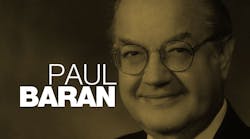To maintain the Cold War stalemate with the Soviet Union, the United States knew it had to develop a hefty communications system that could withstand a nuclear strike and allow for retaliation. If the Soviets knew the U.S. could strike back, they would be less likely to attack. Policymakers weren't the only players in prolonging what seemed inevitable. Solutions rested heavily on the shoulders of engineers like Paul Baran.
"We could stumble into a holocaust very easily unless we had a reliable communication system," Baran says. The question on his mind: "Was it possible to modify our communications network so that it could survive an enemy attack and then be able to respond?"
Baran's proposed solution, a "distributed" communications network that transferred information via "packet switching," was scorned at the time - but it actually laid the grounds for what we know as the Internet. Baran, who has made other significant contributions to communications, is today hailed as one of the 'Net's "grandfathers."
During the early 1960s, most communications networks were "centralized," as one node acted as a hub that conducted switching between other nodes. "Decentralized" networks that incorporated a number of hubs also existed, but were simply centralized networks linked together. Either way, communications could easily break down if any of the central nodes were taken out.
Baran's alternative was a "distributed" network, which resembled a wire mesh of nodes and links. Rather than centralized switches, information could be rerouted easily even if several nodes were lost. He pitched a coinciding idea about how information could travel along this mesh: packet switching. Information would be broken up into message blocks before going out onto the network, which could be rerouted as needed and reassembled at the destination node.
Baran envisioned digital computers as the switches that passed these packets from node to node, a technique that was dubbed "hot potato routing." But to accomplish it, he would have to rely on digital technology, which was in its infancy and lacked the caché of its analog counterpart.
"Everyone said it had to be analog because digital wasn't here yet," Baran says. "I tried to do it with existing technology but that wouldn't cut it."
Much of the communications world berated Baran's ideas at the time. Analog folk didn't understand how a voice conversation could be broken up and switched in the middle, because they couldn't imagine switches moving fast enough, Baran says. Quality would also lack if analog data had to be switched a number of times.
"With analog it was like making a copy of a copy of a magnetic tape. At the end, you couldn't hear one another because (the information) couldn't go more than five links," he says.
His ideas were dismissed - "the polite word," he says. But luckily he found a job at a research problem- solving company, the RAND Corporation. There, he says, "you got to pick your own problems," but your work was challenged and tested by a "tough review process."
Finding Receptive Ears
Baran persevered, preparing briefings that demonstrated why his system was feasible. Finally, his persistence paid off in 1965. The Air Force was in charge of strategic communications at the time, and it formed a committee to investigate Baran's work. When the committee approved it, the search was on for a company to implement the distributed digital network.
AT&T would have been the ideal choice, since it was the premier communications company at the time. But it refused, claiming first that the system would not work. Its second excuse was that Baran's network would require a complete revamp of current networks. AT&T was used to adding to systems in place, not renovating them.
"And why would they want to set up a competitor to themselves?" Baran asks, emphasizing that his ideas had the quiet support of some of the scientists at Bell Labs, AT&T's research arm.
Two years later, Robert Taylor, leader of the Department of Defense's new Advanced Research Projects Agency (ARPA), wanted to focus the agency on networking projects. So, he hired computer scientist Larry Roberts to manage the project. After reading about Baran's work and the work of British scientist Donald Davies, who also developed a concept of packet switching, Roberts decided a good first step would be to connect computers for research.
From Research to Shopping and Beyond
So birthed ARPANET, facilitating communications between researchers and letting them share remote computing resources. With the first four nodes online in December 1969, ARPANET had grown to 16 hubs, mostly universities, by March 1971. And researchers weren't just exchanging papers. They turned ARPANET into a high-speed electronic post office for exchanging random notes, ideas, and personal information.
The "consumer" version of ARPANET, the Internet, had taken off by 1983. Baran's vision, which he presented to the American Marketing Association in a 1966 paper titled "Marketing in the year 2000," was coming into fruition. He predicted consumers would one day do their shopping via a virtual department store, clicking on desired items on a TV set.
"That turned out to be pretty accurate," he says.
While he remained a consultant to ARPANET and Internet projects, Baran's main work has been forming startups based on new technologies that he forges. He has started seven companies, five of which have gone public and three of which have been valued at over $1 billion. And he's picked up a number of awards, like the IEEE Alexander Graham Bell Medal, the Marconi Fellowship Prize, and the Franklin Institute Bower Award for Science.
"I'm a techie," he says. "I come up with an idea for technology and it seems to make sense, so I develop it. I've had good luck."
